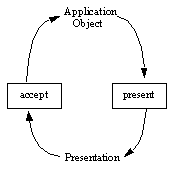






In object-oriented programming systems, applications are built around internal objects that model something in the real world. For example, an application that models a university has objects representing students, professors, and courses. A CAD system for designing circuits has objects representing gates, resistors, and so on. A desktop publishing system has objects representing paragraphs, headings, and illustrations.

Application objects have to be presented to the user, and the user has to be able to interact with them. In CLIM, an interface enables the user to see visual representations of the application objects and, via these representations, operate on the application objects themselves.
A very basic part of designing a CLIM user interface is specifying how the user will interact with application objects. There are two directions of interaction: you must present application objects to the user as output, and you must accept input from the user that indicates application objects. This is done with two basic functions, present and accept , plus some related functions.
Common Lisp Interface Manager 2.0 User's Guide - 20 Sep 2011